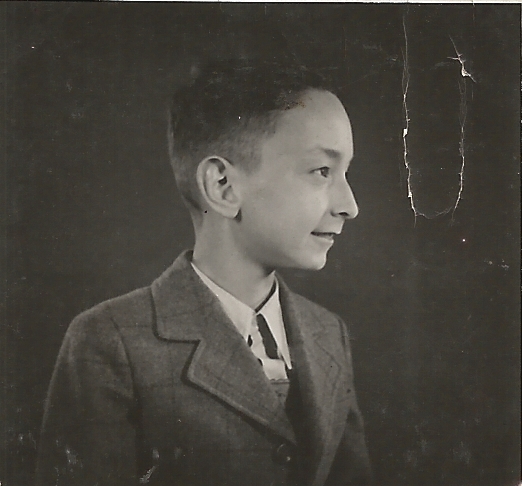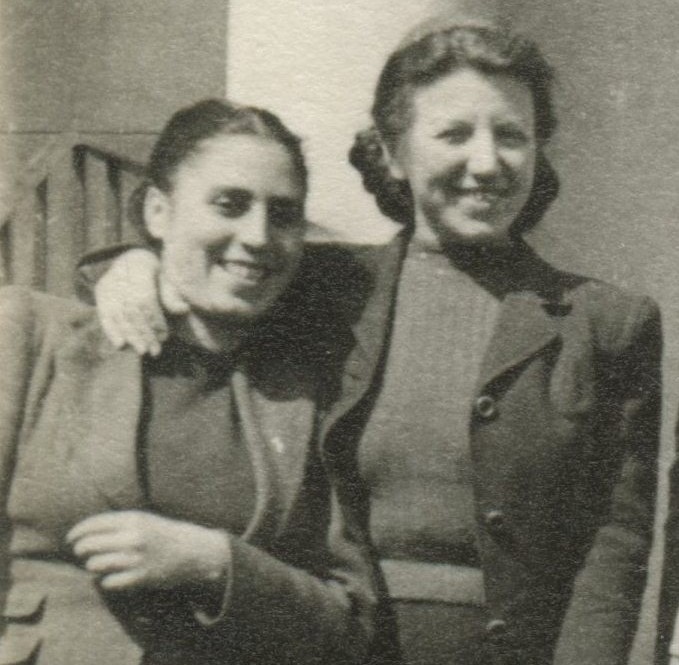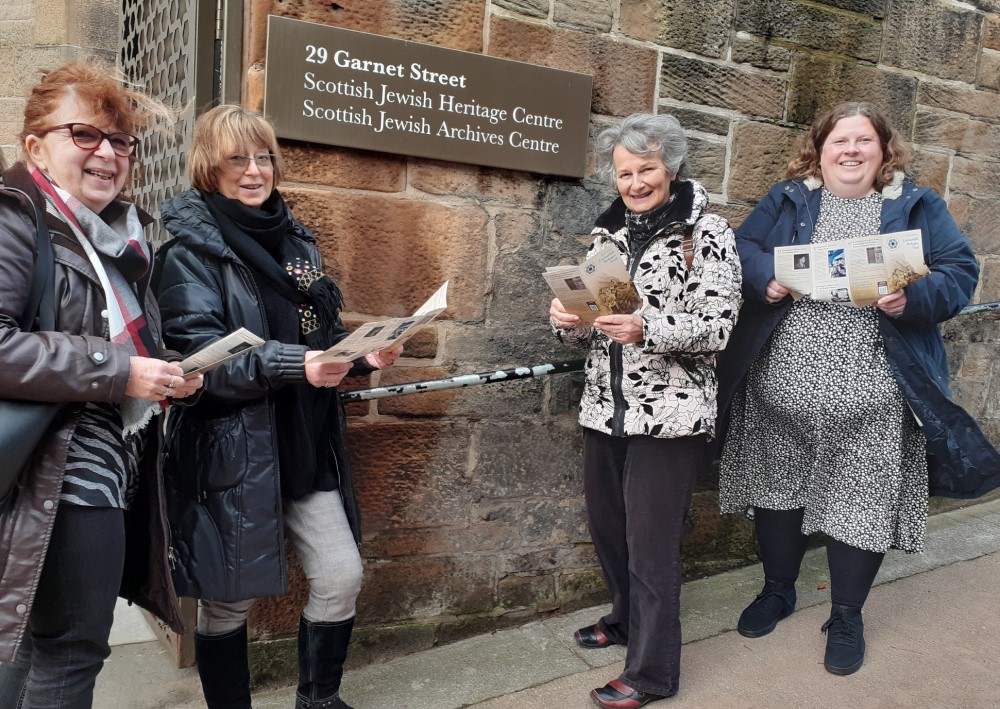The hidden Holocaust-era history of the Garnethill area of Glasgow is revealed in a new heritage walking trail from the Scottish Jewish Heritage Centre.
Using collections from the Scottish Jewish Archives Centre, the trail showcases buildings connected with Jewish refugees who came to Glasgow from Europe before, during and after the Second World War.
The new trail is available free in print format, or can be downloaded from the SJHC website or viewed directly on the site: www.sjhc.org.uk.

When Hitler became Chancellor of Germany in 1933, thousands of Jewish and non-Jewish refugees fled from the Nazi regime to the United Kingdom and neighbouring European countries. Committees in the UK began raising funds for Jews in Germany, and some Jewish people were helped to escape, using schemes such as the Domestic Service Visa to work in Britain. Following the violent anti-Jewish events known as Kristallnacht in 1938, the UK Government agreed to take in 10,000 unaccompanied children up to the age of 17 on the Kindertransport scheme. Each child had to be sponsored. Hundreds of these children came to Scotland and many stayed in the Garnethill area.
The Garnethill Refugee Trail begins at Garnethill Synagogue on Hill Street. Here, the Garnethill Hebrew Congregation was instrumental in supporting refugees by refurbishing a house in the synagogue grounds to be used as a Boys’ Hostel for children who came on the Kindertransport. Refugees Hilda Goldwag and Cecile Schwarzschild, who were saved on Domestic Service Visas, lived in the tenements on Hill Street. On the other side of the synagogue, in Renfrew Street, was the Quaker-run hostel for Jewish women and girls. Many of the children attended the local Primary School, Garnetbank.

Edgar Benjamin from Breslau in Germany (now Wroclaw in Poland) came on the Kindertransport in December 1938 and stayed in the hostel for a time and attended Garnetbank Primary. Image © and courtesy of the Scottish Jewish Archives Centre.

Cecile (left) and Hilda (right) in the 1940s. Image © and courtesy of the Scottish Jewish Archives Centre
Further along Renfrew Street at Glasgow School of Art, Jewish sculptor Benno Schotz helped refugee artists who arrived in the city. Among refugee artists who later taught there were sculptor Paul Zunterstein, artist Frederick Selby and architect Isi Metzstein. The trail extends to Sauchiehall Street, where the Refugee Club (on part of the site of the current Dental Hospital) was an invaluable hub for refugees to meet each other and to mix with local people.
To get your copy of the Trail:
View online: https://sjhc.org.uk/jewish-glasgow-garnethill-refugee-trail/
Download the pdf: https://sjhc.org.uk/downloads/
Pick up a copy at the SJHC- see www.sjhc.org.uk for access
Kerry Patterson, Manager of the Scottish Jewish Heritage Centre: “This trail reveals places in the city that were vital for some of the refugees who made their home in Glasgow. Protest meetings were organised in Glasgow as soon as Hitler came into power in 1933, and the people of Glasgow supported the Jewish refugees who came here in the 1930s and 1940s, just as they support contemporary refugee causes”
Harvey Kaplan, Director of the Scottish Jewish Archives Centre: “Drawing from the Archives Centre’s extensive collections, this new trail emphasises how European Jewish refugees found a safe haven in Glasgow. The Garnethill area has a proud and longstanding record – from the 19th Century to the present – of welcoming immigrants and refugees.”
Philip Rodney, Chair of the Board of the Scottish Jewish Heritage Centre: “The Centre is a unique resource, providing understanding and learning from a Scottish perspective about the Holocaust. This new Trail, our first, takes information from the Centre out into the community and we hope it will encourage local people and visitors to find out more about this fascinating history of Garnethill.”
PHOTOS AVAILABLE
- Refugee boys seated on car outside hostel on Hill Street, 1939 (leaflet cover image)
- The Refugee club on Sauchiehall Street, 1940s
- Hilda Goldwag (1912-2008) on right and Cecile Schwarzschild (1914-1998) on left, who lived at 155 Hill Street
- Group of SJHC volunteers check out the Trail
For further information, images and interviews, please contact:
Kerry Patterson, SJHC Manager Tel: 0141 332 4151 Email: info@sjhc.org.uk
BACKGROUND INFORMATION
SCOTTISH JEWISH HERITAGE CENTRE (SJHC)
Launched in 2021, the SJHC is based in Garnethill Synagogue and offers a weekly guided tour service and a school visit service. It aims to increase access to Scotland’s Jewish and Holocaust-era history, expand access to the collections of the Scottish Jewish Archives Centre and Garnethill Synagogue and its heritage. The SJHC was created in partnership by The Scottish Jewish Archives Centre (SJAC) and Garnethill Synagogue Preservation Trust (GSPT) working alongside Garnethill Hebrew Congregation, with capital grant funding from the National Lottery Heritage Fund; the Association of Jewish Refugees; The Wolfson Family Charitable Trust; The Consulate General of the Federal Republic of Germany, Edinburgh; The Architectural Heritage Fund- William Grant Foundation; The Community Security Trust. www.sjhc.org.uk
SCOTTISH JEWISH ARCHIVES CENTRE (SJAC)
A charity founded in 1987 that collects historical material relating to the experiences of Jewish people in Scotland dating back over 200 years. SJAC’s diverse collections come from current and former Jewish communities in Glasgow, Edinburgh, Tayside/Fife, Aberdeen, Greenock, Inverness, Falkirk, Ayr and Dunfermline. Volunteers are at the heart of SJAC, researching, cataloguing, guiding visitors, fundraising, assisting researchers and organising events and activities. www.sjac.org.uk
GARNETHILL SYNAGOGUE and GARNETHILL SYNAGOGUE PRESERVATION TRUST (GSPT)
The synagogue building opened on its hill top site in Garnethill in 1879 – the first purpose-built synagogue in Scotland, and it is still working today. Today it is a Category A listed building and retains its original stained glass windows, furniture and fittings. It is rated in the top 10 historic synagogues in the UK – the only one in Scotland. The GSPT took over care and management of the building from the congregation in 2012 www.garnethill.org
ENDS

